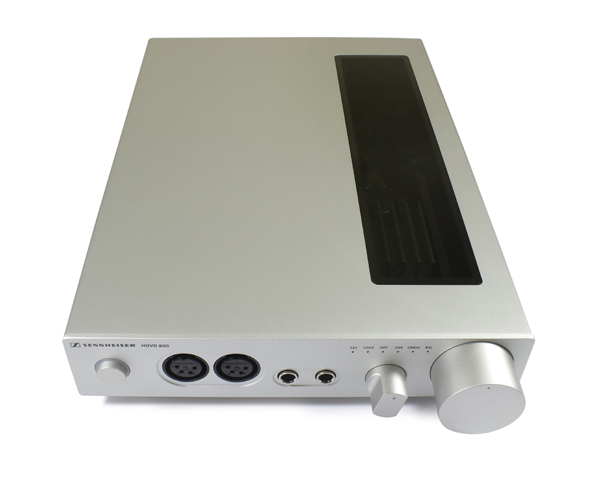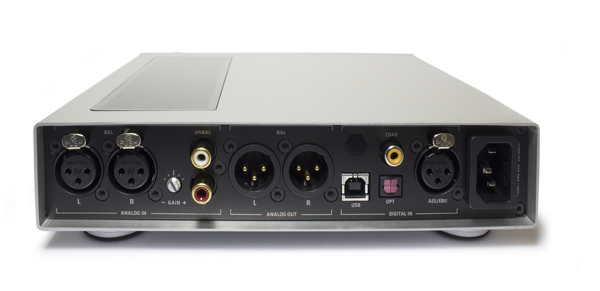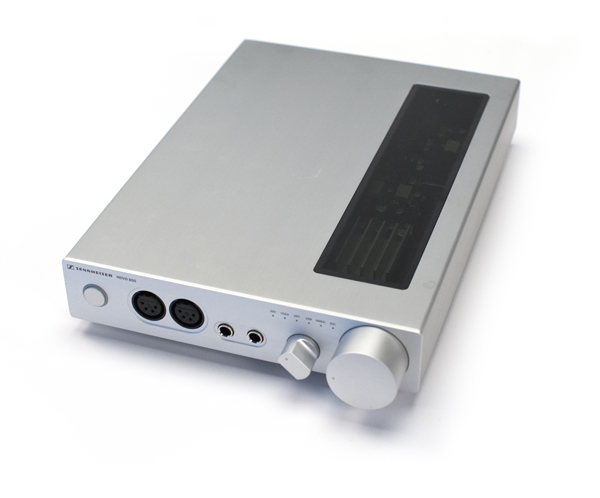Sennheiser HDVD 800 Headphone Amp/DAC
 For a company to be a market leader or maintain its position as one, it has to be bold and willing to take some risks, challenge its R&D team to go beyond its comfort zone and build a product for a market that didn’t previously exist. That’s exactly what Sennheiser did with its flagship headphones, the HD 800s. When the HD 800s launched in 2008, there were only a handful of headphones on the market that exceeded the $1,000 cost barrier. The design of the HD 800s and the engineering that went into producing them were so far ahead of their time that other manufactures are only now starting to catch up.
For a company to be a market leader or maintain its position as one, it has to be bold and willing to take some risks, challenge its R&D team to go beyond its comfort zone and build a product for a market that didn’t previously exist. That’s exactly what Sennheiser did with its flagship headphones, the HD 800s. When the HD 800s launched in 2008, there were only a handful of headphones on the market that exceeded the $1,000 cost barrier. The design of the HD 800s and the engineering that went into producing them were so far ahead of their time that other manufactures are only now starting to catch up.
On the flip side, jumping into a market before it’s been tested can be a hasty move. Learning from your competitors’ mistakes can save you a ton of money and sometimes brand reputation. This is why Sennheiser waited until recently to enter the headphones amp/DAC market.
Baby got DAC
Sennheiser now produces two desktop headphone amplifiers, both of which are designed and built in Germany—like all Sennheiser products. The $1,599 HDVA 600 is solely a headphone amp, while the $1,999 HDVD 800 adds a DAC for compatibility with digital sources. The latter product, which is the focus here, features an internal 24-bit Burr-Brown DAC that supports sampling rates as high as 192 kHz. Both amplifiers are fully balanced in design, with a foolproof front panel that includes a pair of XLR and a pair of 1/4-inch output jacks, allowing the simultaneous use of as many as four headphones. I enjoy being able to use the XLR and 1/4-inch outputs to compare cable differences on one pair of headphones.
The HDVA 800 combines a sleek design aesthetic with a luxurious feel, and the glass window on the top panel, lit with a bank of blue LEDs, allows a look at the interior workings. The Alps potentiometer has a buttery feel, as do the rest of the controls.
A Versatile Machine
Those wanting to connect a CD player or phonostage have the option of balanced XLR analog inputs, while unbalanced RCA inputs offer compatibility with most of your other components. This makes the HDVD 800 a perfect choice for those building a system around their headphones.
Digital sources can be connected to the HDVD 800 via Toslink optical, coaxial S/PDIF, USB 2.0 or high-end digital AES3/EBU cables. If you are using a computer and you don’t want to use USB for audio, there are a few manufactures that make USB-to-Toslink, coaxial and balanced digital AES converter boxes. Balanced digital AES may yield some improvements over the other inputs, but you should experiment to see what best suits your needs and listening preferences; the HDVD 800 lets you experiment with ease.
Owners of Sennheiser’s high-end headphones (HD 600/650, HD 700 or HD 800) take note: The HDVD 800 was certainly voiced with Sennheiser headphones in mind, but it works well with any phones you might have on hand. We’ll start the listening impressions with the HD 800 and work our way down.
Feeling a little jazzy, I start my evaluation with Natalie Cole’s Still Unforgettable (a CD rip) on my MacBook Pro via the HDVD 800’s USB input. The soundstage delivered by the HDVD 800 is big and open, not getting in the way of the HD 800 headphones giving the listener an immersive experience. Cole’s soothing voice sounds so natural with this combo that it leaves me wondering if high-res files are even necessary.
Although the HDVD 800 is capable of delivering 24-bit/192-kHz files, its ability to transport well-mastered 16-bit/44.1-kHz (CD-quality) files is nothing to sneeze at. This is the case of the marriage between the HDVD 800 and HD 800. Switching over to a more fun album, Roy Orbison’s Black & White Night, shows this combination at its finest. I’m no longer listening to headphones driven by an amp; I am in the audience with the best seat in the house. The raw energy, dynamics and vibe of a live performance are here in spades, even though we’re talking about headphones.
The experience is even more powerful through the HD 700s, due to their greater focus on the lower frequencies and a lighter impedance load on the amp. The HDVD 800 has enough headroom to drive either set of phones beyond my comfort level, but if you need more gain, there is a recessed dial that allows even higher volume levels. We do suggest that, if you take this path, you proceed with caution to prevent ear damage.
As good as the HDVD 800 performs with Sennheiser’s latest headphone creations, those with older models will not be disappointed. Revisiting the older HD 650 headphones, a workhorse for many enthusiasts, also turns in an exceptional performance. Tori Amos’ Little Earthquakes, for example, is a recording in heavy rotation with the HD 700s and HD 800s, but the resolution provided by the HDVD 800 closes the gap between new and legacy Sennheiser sound. -Mike Liang
Additional Listening
By Jeff Dorgay
I found the HDVD 800 to provide a very resolving, detailed sound. Going through our arsenal of phones, I discover it to be similar to most other headphone amplifiers we’ve auditioned. It is a matter of synergy, however. Here’s a quick rundown:
The most difficult phones I have to drive, the HiFiMAN HE-6s, are the least-compatible choice for the Sennheiser amplifier, proving to be too much of a good thing. The sound is almost hyper detailed and somewhat lacking in dynamics. On the other side of the spectrum, the Audeze LCD-2 and LCD-3 both prove an excellent match with the HDVD 800, yielding smooth responses overall, with tight and controlled bass.
Both my Grado PS500 and PS1000 phones are decent matches, as well, with the sonic texture very similar to that presented by the excellent AURALiC Taurus, which we use as one of our reference amplifiers. When matched with the HDVD 800, the Grados offer a neutral and accurate portrayal of music with no embellishment. Those liking the warmer reproduction of a tube amplifier may not prefer this presentation, but those in search of accuracy would do well to seek this one out. Even my vintage Koss and Sennheiser phones work well, and the HDVD 800 has plenty of drive for anything I throw at it—so no matter what phones you have, it should prove up to the task.
Running the DAC through its paces with a wide range of sources from MP3 to 24/192 files is a joy and, if you need a DAC, the HDVD 800 is well worth the $400 increase in price over the HDVD 700. Whether you are looking to build a second system or a primary system that doesn’t take up a lot of space, the Sennheiser HDVD 800 will prove a worthwhile anchor.





